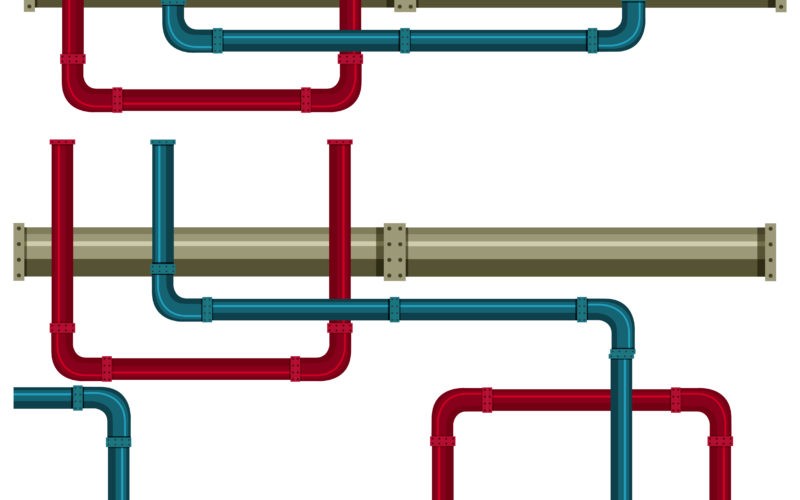Among the key issues for industrial plants, energy losses in air pipelines stand out since they increase the cost of operation, worsen the efficiency of processes, and decrease the overall performance of the system. Industrial facilities can achieve energy savings ranging from 20 to 50 percent or more in their compressed air systems, potentially translating to thousands or even hundreds of thousands of dollars in annual cost reductions. Proper design, maintenance, and management of these systems can help reduce energy waste and allow facilities to operate more sustainably and cost-effectively. Air leakage, pressure drops, and inefficient flow control are some of the major problems associated with compressed air systems in any industrial plant. By understanding these issues and taking strategic steps to address them, plant managers can improve the efficiency of their air pipelines and decrease energy consumption.
Understanding the Causes of Energy Loss in Air Pipelines
The main reasons for losses in compressed air pipelines are found in problems related to leakage, inappropriate flow rates, or the use of old and/or inefficient equipment. This is because leaking air in pipes forces the system to work harder by increasing pressure and, consequently, energy consumption. Even minor leakage results in huge losses on a large scale when it comes to industrial facilities receiving huge amounts. Poor design of routing of the pipelines, again, increases the numbers of bends-one that can be long-necessitating falls in pressure and therefore increased energy loss. If not controlled and maintained, all such problems multiply to increase operational cost and simultaneously reduce system efficiencies.
Optimizing Pressure Levels of Air for Efficiency
One important feature of the best practice is the minimization of air pressure loss in pipelines. Whereas there is this seemingly logical idea to increase the pressure with a view to ensuring that smooth flow is attained, higher levels actually result in higher consumptions of energy. Every additional bar adds a lot of energy, and over-pressurizing results in just wasted energy. On the other hand, a pressure too low may also lead to poor performance and failure of equipment. A balance needs to be struck; thus, in industrial plants, it is prudent that the lowest pressure at which operational requirements are fulfilled should be worked upon. All along the pipeline network, air pressure should be regularly monitored as part of overall energy use optimization.
Efficient Airflow Management and Pipe Sizing
Another major causing agent for energy loss is airflow management in the pipeline. Actually, airflow should be matched with the demand of the system. Due to the over-sizing of pipelines, the inefficiency results in inefficient flow rates and wastes energy, while a lesser diameter pipeline results in pressure drops, affecting performance. Correct calculations of the required airflow at the plant site and appropriate sizing of the pipe to match these needs will yield the most energy-friendly system. System analysis and adjustment in design would be done for that purpose. A plant minimizes the gap between the demand for air flow and the pipeline capacity, hence cutting down both the operational cost and energy losses during the process.
Regular Maintenance and Inspections
One of the most effective ways of minimizing energy loss within air pipelines is through regular maintenance and inspections. Over time, pipes will develop cracks, leaks, and blockages that result in wasted energy. Ensuring the pipeline network is clean and in good condition is vital to maintaining efficient airflow and pressure. Leak checks and replacement of worn-out parts are some of the preventive maintenance procedures that can significantly reduce the chances of energy loss brought by malfunctioning parts. Besides, a check schedule for valves, regulators, and other key system components will allow one to spot potential problems before they cause expensive problems. Ball valves are usually used for regulating the flow of air in industrial systems and should be inspected for leaks or wear; a faulty valve may lead to massive energy inefficiencies.
Installation of Energy-Efficiency Equipment and Technologies
Investment in energy-efficient equipment and technologies will further reduce energy losses in air pipeline systems. Newer designs of air compressors, for example, work to ensure that they operate more efficiently than their predecessors. They use less energy to develop the same amount of compressed air. The most effective in the reduction of energy consumption, especially in times of low demand, are variable speed drive compressors, which alter their speed based on demand. The installation of energy-efficient air treatment equipment such as dryers and filters increases compressed air quality and minimizes waste in energy consumption. Implementation of smart technologies, like real-time monitoring systems, helps the plant operators to track performance of the air pipeline system constantly and thus take the required measures for optimal efficiency.
Pressure Drop in Pipeline Design
The pressure drop is another major contributor to energy loss in the air pipelines, and the ways of overcoming it start with proper design of the pipeline. The longer the pipeline is and the more bends it has, the larger the pressure drop will be. Pressure drop occurs when air flows inside the pipeline, and due to friction between the air and the inner walls of the pipes, the air pressure becomes reduced. This requires the air compressor to put in more effort to achieve the needed pressure and thus uses up plenty of energy. To minimize pressure drop, pipelines should be as short and straight as possible with fewest bends; pipes should be smooth and of high quality. Plants can also reduce airflow resistance inside the pipeline to decrease energy required to achieve the desired pressure.
Demand-Responsive Air Systems
One of the best ways to reduce air pipeline system losses is by designing demand-responsive air systems. These are supposed to work toward adjusting the volume of compressed air produced according to instantaneous demand, consequently reducing energy during low usage periods. By monitoring the demand for compressed air throughout the entire plant and trimming the output of the compressors, plants avoid the running of compressors at full capacity during off-peak hours. The pressure and flow control systems, for example, regulate the pressure and airflow by automatically adjusting to the instantly changing needs and preventing the wastage of energy. It finds applications where compressed air demand is quite erratic, especially in the daytime in a plant, manufacturing, or packaging line.
Employee Training and Awareness
Employee training regarding energy efficiency and making employees realize their roles in preventing the loss of energy are also necessary to keep the air pipeline system at an optimal performance. Operators and maintenance personnel should be well versed in the principles of air system efficiency and trained to recognize potential problems that result in energy losses. The employees can be educated on the importance of prompt repairs of leaks, avoidance of unnecessary air consumption, and proper shutdown of equipment when not in use, which will go a long way toward overall energy savings. By instilling energy awareness in their culture, the industrial plants can make sure that every single team member is contributing towards this very objective of minimizing energy losses to ensure the best performance of the system.
Conclusion
Energy loss in air pipelines is something that can be achieved minimally by thoughtful design, regular maintenance, and adoption of modern technologies. Pressure optimization, efficient airflow management, and the installation of energy-efficient machinery are areas of concentration by industrial plants in mitigating energy consumption and further increasing the efficiency of air pipeline systems. Long-term efficiency could be ensured by means of regular inspections, demand-responsive systems, and employee training. As industries continue to prioritize sustainability and cost-effectiveness, the importance of minimizing energy loss in air pipelines will only continue to grow. Through proactive measures and a commitment to continuous improvement, industrial plants can create more efficient, sustainable air systems that benefit both their bottom line and the environment.












